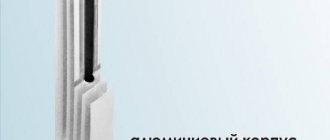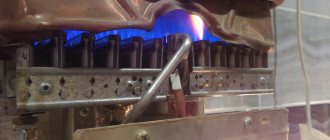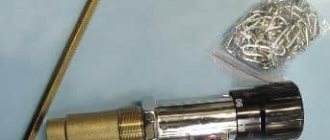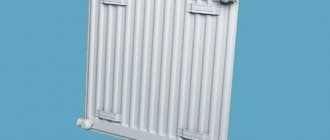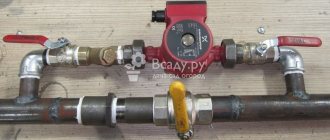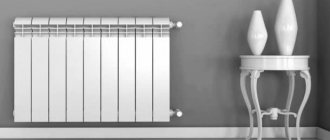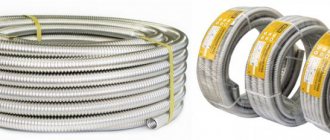How to choose the power of a panel radiator and its type
The power of any radiator depends on the heat loss of the room. In general, it is pleasant to assume that heating 1 m2 of area requires 100 W of heat. This is approximately how you can calculate it. If a radiator is needed for a room of 16 m2, then 1600 W will be required to heat it.
Next, you need to use the tables to find possible options: look for power close to the required one. For example, for our option it is suitable:
- type 11-300-2200 - power 1682 W;
- type 20-300-1900 - 1608 W;
- type 21-300-1400 - 1616 W;
- type 22-300-1200 - 1674 W;
- type 33-300-900 - 1762 W;
- type 10-500-2000 - 1613 W;
- type 11-500-1400 - 1704 W;
- type 20-500-1300 - 1699 W;
- type 21-500-1100 - 1760 W;
- type 22-500-800 - 1734 W;
- type 33-500-600 - 1823 W.
What do these numbers mean:
- first - type - number of panels and finning plates;
- the second is the height of the radiator;
- the third is its length.
From the entire list, you now need to choose the most suitable size for your conditions. It must be remembered that for normal air circulation it is necessary to maintain certain distances to the floor and window sill. It is advisable to select them based on them. It is also advisable to take into account that the battery should cover 70-75% of the window width. Then the window will not “sweat” and condensation will not form on the wall.
Technical characteristics and scope of application
Prado radiators are made of steel alloys, and they are susceptible to corrosive processes, so they can only be used when installing closed-type heating systems. In this case, they will last quite a long time.
If you plan to replace the heating system in an apartment building, first of all, you need to contact the operating organization to clarify its parameters. The choice of the type of heating units for the apartment depends on the state in which it is located.
Multi-storey buildings are currently supplied with heat according to different schemes. If the house is connected in accordance with an independent option or there is an individual water treatment system, then batteries can be installed from any metal, including steel alloy.
If the heating system is dependent, this means that the building is connected directly, then the quality and composition of the coolant should be clarified.
Prado radiators made of steel alloys can be used in heating structures that have certain parameters:
- water temperature no more than 120 degrees;
- with a material thickness of 1.2 millimeters, the working pressure should be 0.9 MPa, and with 1.4 millimeters - 1.0 MPa;
- the required crimping pressure when using steel with a thickness of 1.2 millimeters is 1.25 MPa, and when using steel with a thickness of 1.2 millimeters - 1.5 MPa;
- the required tensile pressure if the sheet thickness is 1.2 millimeters is 2.25 MPa, and 1.4 millimeters is 2.5 MPa;
- for a working environment, hydrogen activity should be in the range from 8 to 9.5, but it is better if 8.3 - 9.
Experts warn: if steel panel appliances are not suitable for at least one of the above indicators, you need to pay attention to another type of heating radiators. These can be cast iron or bimetallic devices.

The amount of various impurities in the coolant is of no small importance. If there are filters and mud traps on the riser, then usually their number is small. In the case of direct connection to the central heating supply line, you should not purchase panel radiators made of steel alloys.
The reason is that vertically located manifolds for moving the working medium have such a narrow cross-section that the presence of a significant amount of suspended particles leads to them becoming clogged. Since Prado radiators are a non-separable structure, it will be difficult to do anything if the coolant circulation is disrupted.
In order to prevent siltation when connecting to central heating mains, additional filters and mud collectors should be installed at the supply point at the entrance to the device.
Radiators from the Prado brand
Prado heating radiators are produced at a domestic enterprise in Izhevsk. Today they are available for purchase almost anywhere in Russia. The products of the brand of the same name have repeatedly received well-deserved diplomas, distinguished by their high build quality. It is confirmed by numerous user reviews.
Prado radiators are made of durable steel. It is used to form panels with fins, which is necessary to increase the effective area. The thickness of the steel sheets is 1.2 mm - this is more than enough to produce reliable and durable heating equipment that is resistant to corrosion and high pressure in the line. The products undergo final testing, exposed to excess pressure up to 13.5 atmospheres.
Scope of application:
- Heating of private households and cottages.
- Heating of commercial buildings (offices, work rooms).
- Heating of utility and industrial buildings.
The maximum pressure in the batteries is limited to 9 atmospheres.
Prado steel radiators are represented by the following modifications:

Prado radiators are currently represented by a huge number of different models, differing both in functionality and size. Choosing an option for yourself will not be much of a problem.
- Type 10 - thin single-row samples without fins, have minimal power.
- Type 11 – one panel with dissipative fins.
- Type 20 – double-row radiators without fins. Available in the hygienic modification Z, without fins and air outlet grilles.
- Type 21 – double-row batteries, the front panel is equipped with fins.
- Type 22 is a similar variety with fins on two panels at the same time.
- Type 30 – three panels without fins. A hygienic modification with the Z index is also implemented.
- Type 33 - three-row, each panel is equipped with fins (the most efficient heat transfer).
There is also a division by size:
- Height – 300 or 500 mm (for high or low windows).
- Length – from 400 to 3000 mm.
- Depth (thickness) – from 80 to 200 mm.
Connection – bottom or side.
Some models are available with thermostatic valves, allowing for separate temperature control in heated rooms.
Equipment for installation and connection
Prado panel radiators have excellent technical characteristics. They can operate at increased pressure in the line, and a wide range of models allows you to select batteries for the area of the heated premises. In addition to them, Prado produces auxiliary equipment:
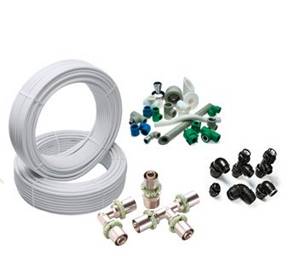
It is best to check the cost of radiators, fittings, pipes and other equipment from Prado from official dealers - you will find the lowest prices there.
- Convenient floor mounts that facilitate installation work.
- Thermostatic valves.
- Thermostatic elements.
- Manual control valves.
- Reverse flow valves.
- Bottom connection nodes.
- Plastic and copper pipes.
- Reduction couplings.
- Connectors are straight, triple and angled.
- Fasteners, adapters and much more that is necessary to build a heating system.
Fastenings
| A* | B | C | |
| 400 | 99/104 | 166 | — |
| 500 | 132/137 | 200 | — |
| 600 | 132/137 | 300 | — |
| 700 | 132/137 | 400 | — |
| 800 | 132/137 | 500 | — |
| 900 | 132/137 | 600 | — |
| 1000 | 132/137 | 700 | — |
| 1100 | 132/137 | 800 | — |
| 1200 | 232/237 | 700 | — |
| 1300 | 232/237 | 800 | — |
| 1400 | 232/237 | 900 | — |
| 1500 | 232/237 | 1000 | — |
| 1600 | 232/237 | 1100 | — |
| 1700 | 232/237 | 1200 | — |
| 1800 | 232/237 | 1300 | 667 |
| 1900 | 232/237 | 1400 | 717 |
| 2000 | 232/237 | 1500 | 767 |
| 2200 | 232/237 | 1700 | 867 |
| 2400 | 232/237 | 1900 | 967 |
| 2600 | 232/237 | 2100 | 1067 |
| 2800 | 232/237 | 2300 | 1167 |
| 3000 | 232/237 | 2500 | 1267 |
| L | A* | B | C |
| 400 | 50 | 300/166 | — |
| 500 | 150 | 200 | — |
| 600 | 150 | 300 | — |
| 700 | 150 | 400 | — |
| 800 | 150 | 500 | — |
| 900 | 150 | 600 | — |
| 1000 | 150 | 700 | — |
| 1100 | 150 | 800 | — |
| 1200 | 250 | 700 | — |
| 1300 | 250 | 800 | — |
| 1400 | 250 | 900 | — |
| 1500 | 250 | 1000 | — |
| 1600 | 250 | 1100 | — |
| 1700 | 250 | 1200 | — |
| 1800 | 250 | 1300 | 650 |
| 1900 | 250 | 1400 | 700 |
| 2000 | 250 | 1500 | 750 |
| 2200 | 250 | 1700 | 850 |
| 2400 | 250 | 1900 | 950 |
| 2600 | 250 | 2100 | 1050 |
| 2800 | 250 | 2300 | 1150 |
| 3000 | 250 | 2500 | 1250 |
L-length of radiator
A,B,C - Bracket distance
*-Below the decimal line are options for installing brackets with a small shelf to the wall.
Advantages and disadvantages of Prado batteries
To understand how relevant it is to install Prado radiators, you need to carefully weigh the pros and cons. Of course, you are unlikely to be disappointed in such a purchase, but it will be interesting to learn about its advantages and disadvantages.
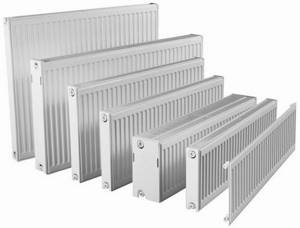
First of all, we propose to discuss the advantages of Prado batteries:
- For the manufacture of such structures, steel coated with a special composition is used. It prevents the product from rusting and significantly increases its service life.
- The elements of such batteries are connected by spot welding. It looks neater than the usual connection option.
- Prado radiators have a large selection of different shapes and sizes. They can also vary in design.
- Such batteries can be connected both from above and from below.
- Not a bad price that definitely won’t upset you.
In addition to the obvious advantages, Prado radiators also have disadvantages. There are not many of them, but they are worth mentioning.
Disadvantages of the Prado battery:
- The upper pressure limit of such batteries is only 0.9 MPa. In some cases, this indicator is not enough.
- If there is no water in such a battery for more than two weeks, the equipment will begin to rust.
It is precisely because of the latter drawback that such systems are not recommended for use in centralized heating systems. Indeed, in this case, there may be water shutdowns beyond your control.
Features of installation and operation
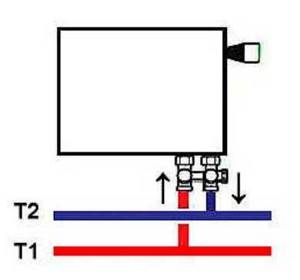
When installing a radiator with a bottom connection, you cannot confuse the supply with the return - it will not heat
In options with a lower connection (bottom) of the coolant, you need to take into account that the supply is the second entrance from the side edge, the “return” is always located at the edge. It is impossible to change places: a tube is welded to the supply inlet, which transports the hot coolant to the upper collector, and from there it spreads through all vertical channels.
To install Prado panel radiators, the manufacturer recommends using the included brackets: they are designed specifically for these heating devices. They are inserted into special grooves on the back wall of the panel. There can be 2 or 3 brackets depending on the length of the battery. It is possible to install it on legs rather than on the wall. But branded legs must be ordered separately.
The installation sequence is as follows:
- the installation locations of the brackets are marked on a flat, prepared wall;
- the brackets are unpacked;
- strengthened with dowels or mortar on the wall;
- a Mayevsky valve (required) or an automatic air vent, if available, a thermostat or plugs, and adapters if necessary, is installed on the radiator;
- in places where they are hung on brackets, the packaging of the radiators is torn, they are installed in place;
- coolant supply and discharge pipelines are connected;
- Completely polyethylene packaging is removed after finishing work.
When using water as a coolant, it must meet the following parameters:
- oxygen no more than 0.02 mg/kg;
- iron up to 0.5 mg/l;
- other impurities no more than 7 mg/l;
- total hardness up to 7 mEq/l.
Like most radiators (except cast iron), steel ones are negatively affected by “dry” downtime without coolant. Frequent short-term drains, for example, during system repairs, have a particularly bad effect. The total duration of heating devices without water should not exceed 15 days per year.
Steel radiators are compatible with any type of pipes, only with copper they must be connected through brass or bronze fittings and adapters.
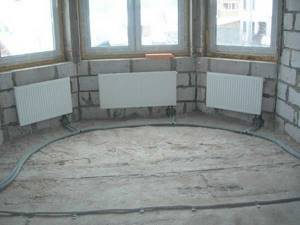
These heating devices with a shallow depth are good
Features of Prado batteries
Production
To get an idea of the products in question, you should first familiarize yourself with the production features, which are listed below:
- As mentioned above, Prado batteries are manufactured in factory conditions at facilities. The main raw material for heating appliances is high-carbon steel with a thickness of at least 1.2 - 1.4 mm. The production of radiators begins with cutting steel sheets according to the standard sizes of future radiators.
- Then the blanks are subjected to pressure treatment in a stamping machine, as a result of which they acquire the required profile.
- Two stamped blanks are welded using modern technology, resulting in a panel. Prado heating radiators, depending on the model, may contain one, two or even three such panels, between which ribs made of thinner steel are welded, which increases the heat transfer of the device.
Finished products are first painted using the electric dip method, after which they are coated with durable powder paint. Thanks to this, the products not only look attractive, but are also reliably protected from corrosion.

Radiator grille for air convection
Advantages
The popularity of Prado radiators is associated with their following advantages:
- The structure is lightweight, making it easy to install it yourself. Moreover, the mounting brackets are very convenient, the only thing is that before installing the battery, you should familiarize yourself with the mounting diagram.
- Effective heat transfer and high heating rate.
- Panel batteries look attractive, and thanks to the use of high-quality paint, they remain white for a long time.
- Models with multiple panels provide air convection, which increases heating efficiency.
- The price is quite affordable.
- Durability if the operating rules are followed.

Radiator Prado in the interior of the room
Flaws
The disadvantages of Prado radiators are associated with design features, so they are common to all panel radiators.
In particular, the following points can be highlighted:
- The devices are not intended for use in centralized heating systems, as they cannot withstand high pressure and water hammer, and also require clean coolant.
- The coolant temperature should not exceed 120 degrees Celsius.
- The operating instructions for the devices do not recommend draining water from the system, as this can cause corrosion inside the panels.
- The impossibility of accurately adjusting the heating temperature even in models equipped with a thermostat.
- Problems with the varnish have been reported on some models.
Of course, many models of modern radiators do not have the above-mentioned disadvantages, however, if we compare the price/quality ratio, Prado radiators clearly win. The only thing is that before purchasing you need to make sure that the characteristics of the heating system match the characteristics of the radiators.

Design diagram of the Prado radiator range
Capacity and weight
*/** *-Weight (kg) **-Capacity (l)
| H=300 | |||||||
| 10 | 11 | 20 | 21 | 22 | 30 | 33 | |
| 400 | 2,95/0,75 | 4,05/0,75 | 5,70/1,5 | 6,38/1,5 | 7,43/1,5 | 9,03/2,25 | 11,24/2,25 |
| 500 | 3,51/0,94 | 4,83/0,94 | 6,87/1,88 | 7,72/1,88 | 8,96/1,88 | 10,79/2,82 | 13,55/2,82 |
| 600 | 4,07/1,13 | 5,61/1,13 | 8,04/2,26 | 9,06/2,26 | 10,49/2,26 | 12,55/3,39 | 15,86/3,39 |
| 700 | 4,63/1,32 | 6,39/1,32 | 9,21/2,64 | 10,40/2,64 | 12,02/2,64 | 14,35/3,96 | 18,17/3,96 |
| 800 | 5,19/1,51 | 7,17/1,51 | 10,38/3,02 | 11,74/3,02 | 13,55/3,02 | 16,11/4,53 | 20,48/4,53 |
| 900 | 5,75/1,7 | 7,95/1,7 | 11,55/3,4 | 13,08/3,4 | 15,08/3,4 | 17,87/5,1 | 22,79/5,1 |
| 1000 | 6,31/1,89 | 8,73/1,89 | 12,72/3,78 | 14,42/3,78 | 16,61/3,78 | 19,63/5,67 | 25,10/5,67 |
| 1100 | 6,87/2,08 | 9,51/2,08 | 13,89/4,16 | 15,76/4,16 | 18,14/4,16 | 21,39/6,24 | 27,41/6,24 |
| 1200 | 7,43/2,27 | 10,29/2,27 | 15,19/4,54 | 17,23/4,54 | 19,86/4,54 | 23,49/6,81 | 30,03/6,81 |
| 1300 | 7,99/2,46 | 11,07/2,46 | 16,36/4,92 | 18,57/4,92 | 21,39/4,92 | 25,25/7,38 | 32,34/7,38 |
| 1400 | 8,55/2,65 | 11,85/2,65 | 17,53/5,3 | 19,91/5,3 | 22,92/5,3 | 27,01/7,95 | 34,65/7,95 |
| 1500 | 9,11/2,84 | 12,63/2,84 | 18,70/5,68 | 21,25/5,68 | 24,45/5,68 | 28,78/8,59 | 36,96/8,52 |
| 1600 | 9,67/3,03 | 16,41/3,03 | 19,94/6,06 | 22,66/6,06 | 26,07/6,06 | 30,81/9,09 | 39,51/9,09 |
| 1700 | 10,23/3,22 | 14,19/3,22 | 21,11/6,44 | 24,00/6,44 | 27,60/6,44 | 32,57/9,66 | 41,82/9,66 |
| 1800 | 10,92/3,41 | 15,07/3,41 | 22,36/6,82 | 25,42/6,82 | 29,21/6,82 | 34,33/10,23 | 44,13/10,23 |
| 1900 | 11,48/3,6 | 15,85/3,6 | 23,53/7,2 | 26,76/7,2 | 30,74/7,2 | 36,09/10,8 | 46,44/10,8 |
| 2000 | 12,04/3,79 | 16,63/3,79 | 24,70/7,58 | 28,10/7,58 | 32,27/7,58 | 37,88/11,37 | 48,75/11,37 |
| 2200 | 13,16/4,17 | 18,19/4,17 | 27,04/8,34 | 30,78/8,34 | 35,33/8,34 | 40,53/12,51 | 53,37/12,51 |
| 2400 | 14,28/4,55 | 19,75/4,55 | 29,38/9,1 | 33,46/9,1 | 38,89/9,1 | 44,00/13,65 | 57,99/13,65 |
| 2600 | 15,40/4,93 | 21,31/4,93 | 31,72/9,86 | 36,14/9,86 | 41,45/9,86 | 47,44/14,79 | 62,61/14,79 |
| 2800 | 16,52/5,31 | 22,87/5,31 | 34,06/10,62 | 38,82/10,62 | 44,51/10,62 | 50,89/15,93 | 67,23/15,93 |
| 3000 | 17,64/5,69 | 24,43/5,69 | 36,40/11,38 | 41,50/11,38 | 47,57/11,38 | 54,36/17,07 | 71,85/17,07 |
| H=500 | |||||||
| 10 | 11 | 20 | 21 | 22 | 30 | 33 | |
| 400 | 4,47/1,12 | 6,35/1,12 | 8,92/2,25 | 10,20/2,25 | 11,93/2,25 | 13,96/3,37 | 18,04/3,37 |
| 500 | 5,41/1,4 | 7,66/1,4 | 10,85/2,82 | 12,45/2,82 | 14,52/2,82 | 16,86/4,21 | 21,94/4,21 |
| 600 | 6,35/1,68 | 8,97/1,68 | 12,78/3,38 | 14,70/3,38 | 17,11/3,38 | 19,76/5,05 | 25,84/5,05 |
| 700 | 7,29/1,96 | 10,28/1,96 | 14,71/3,94 | 16,95/3,94 | 19,70/3,94 | 22,67/5,89 | 29,74/5,89 |
| 800 | 8,23/2,24 | 11,59/2,24 | 16,64/4,5 | 19,20/4,5 | 22,29/4,5 | 25,54/6,74 | 33,64/6,74 |
| 900 | 9,17/2,52 | 12,90/2,52 | 18,57/5,07 | 21,45/5,07 | 24,88/5,07 | 28,44/7,58 | 37,54/7,58 |
| 1000 | 10,11/2,8 | 14,21/2,8 | 20,50/5,63 | 23,70/5,63 | 27,47/5,63 | 31,34/8,42 | 41,44/8,42 |
| 1100 | 11,05/3,08 | 15,52/3,08 | 22,43/6,19 | 25,95/6,19 | 30,06/6,19 | 34,24/9,26 | 45,34/9,26 |
| 1200 | 11,99/3,36 | 16,83/3,36 | 24,49/6,76 | 28,33/6,76 | 32,84/6,76 | 37,42/10,11 | 49,55/10,11 |
| 1300 | 12,93/3,64 | 18,14/3,64 | 26,42/7,32 | 30,58/7,32 | 35,43/7,32 | 40,32/10,95 | 53,45/10,95 |
| 1400 | 13,87/3,92 | 19,45/3,92 | 28,35/7,88 | 32,83/7,88 | 38,02/7,88 | 43,22/11,80 | 57,35/11,8 |
| 1500 | 14,81/4,2 | 20,76/4,2 | 30,28/8,44 | 35,08/8,44 | 40,61/8,44 | 46,13/12,64 | 61,25/12,64 |
| 1600 | 15,75/4,48 | 22,07/4,48 | 32,28/9,01 | 37,40/9,01 | 43,29/9,01 | 49,27/13,48 | 65,39/13,48 |
| 1700 | 16,69/4,76 | 23,38/4,76 | 34,21/9,58 | 39,65/9,58 | 45,88/9,58 | 52,14/14,32 | 49,29/14,32 |
| 1800 | 17,76/5,04 | 24,79/5,04 | 36,22/10,14 | 41,98/10,14 | 48,55/10,14 | 55,04/15,17 | 73,19/15,17 |
| 1900 | 18,70/5,32 | 26,10/5,32 | 38,15/10,7 | 44,23/10,7 | 51,14/10,7 | 57,94/16,01 | 77,09/16,01 |
| 2000 | 19,64/5,6 | 27,41/5,6 | 40,08/11,27 | 46,48/11,27 | 53,73/11,27 | 60,84/16,85 | 80,99/16,85 |
| 2200 | 21,52/6,16 | 30,30/6,16 | 43,94/12,39 | 50,98/12,39 | 58,91/12,39 | 65,74/15,54 | 88,79/18,54 |
| 2400 | 23,40/6,72 | 32,65/6,72 | 47,80/13,52 | 55,48/13,52 | 64,09/13,52 | 71,46/20,22 | 96,59/20,22 |
| 2600 | 25,28/7,28 | 35,27/7,28 | 51,66/14,64 | 59,98/14,64 | 69,27/14,64 | 77,15/21,91 | 104,39/21,91 |
| 2800 | 27,16/7,84 | 37,89/7,84 | 55,52/15,77 | 64,48/15,77 | 74,45/15,77 | 82,88/23,60 | 112,19/23,6 |
| 3000 | 29,04/8,4 | 40,51/8,4 | 59,38/16,9 | 68,98/16,9 | 79,63/16,9 | 88,60/25,28 | 119,99/25,28 |
Engines
Prado engines are in-line or V-type, with 4 and 6 cylinders. Engine types: gasoline, diesel. Performance varies by model.
Cars of the 70 series were produced with a diesel engine with a volume of 2.4 liters (85 hp) and 3.0 (130 hp). Turbocharged engines had 4 cylinders.
The 90 series was produced with 6 types of engines.
- 2 petrol - with a volume of 2.7 l and 3.4 l. Power 150 and 185 hp. With. respectively.
- 4 diesel engines - turbocharged, with a volume of 2.8 (91 hp) and 3 liters (97, 170, 173 hp).
Generation 120 was equipped with 4 types of gasoline engines, 2 types of turbine diesel engines, and 1 naturally aspirated diesel engine.

- Gasoline engines had capacities of 150 and 160 hp. With. for volume 2.7 l, 185 l. from . to 3.4 l, 249 l. With. for 4 liter volume.
- Diesel engines with turbocharging were 3 liters, with a power of 163 and 166 hp. With.
- Atmospheric engine 3 l (95 hp).
Under the hoods of the latest series of SUVs there are 3 types of engines:
- atmospheric 2.7 l, power 163 l. pp., with 4 cylinders and multi-point (distributive) injection design;
- turbocharged 2.8 liters for 177 hp. p., installed Common Rail and intercooler, diesel;
- V6 turbocharged 4.0 l and 282 hp. pp., fuel is injected through the distribution system.
Design
Prado batteries are panel heating devices. They consist of two stamped blanks, which are molded under a press from a steel sheet. The standard sheet thickness is 1.2 mm; upon request, modifications are made from steel 1.4 mm thick (the model name contains the letter “T”). When stamping, two horizontal channels are formed - at the top and bottom, and vertical - 3 pieces per 10 cm of length.
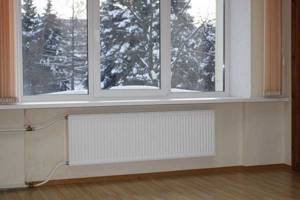
Panel radiators look good
Along the vertical channels, two workpieces are connected by spot welding (welding is done from the back side and is not visible on the front panel). Then they are welded along the perimeter with a continuous seam. To increase heat transfer, ribs formed from a steel sheet 0.4-0.5 mm thick can be welded to the back side of such a panel. The shape of the ribs resembles the letter “P”.
Depending on the number of panels and the presence or absence of additional finned plates between them, panel radiators of the same size have different thermal power, as well as depth and weight. The number of panels and additional convective fins is displayed in the name of the heating device. Type 10 means that there is only one panel with coolant, type 20 - two panels, 11 and 21 - one and two panels with one row of fins. The maximum number of panels and ribs is 3.
The height of Prado steel radiators is 300 mm and 500 mm, width from 400 mm to 3000 mm, depth depends on the type and varies from 72 mm to 174 mm.
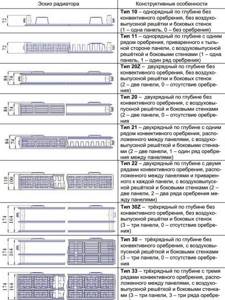
Types of panel steel radiators and their brief description (Click on the picture to enlarge it)
Characteristics of Prado radiators
The lineup
Today, six types of steel panel radiators are produced under the Prado brand:

Radiator range
- Type 10 - single-panel heating radiator, without welding fins. This model is the simplest and therefore has the lowest cost.
- Type 11 – single-panel radiator, equipped with one row of fins to increase heat transfer. Prado type 11 radiators are equipped with side walls and an air outlet grille.
- Type 20 – two-panel steel radiator without additional fins. Like the previous model, the Type 20 radiator is equipped with air outlet grilles and side walls.
- Types 21 and 22 are two-panel radiators with one and two rows of additional fins, respectively. The configuration of these radiators is similar to that of type 20 radiators.
- Type 33 - the most powerful and modern radiators. This model includes three rows of steel radiator panels with three rows of welded fins.
As for the diagrams for connecting radiators to the heating network, each type of radiator can be made in two versions:
Prado Classic for lateral connection is equipped with four connecting pipes.
Prado Universal for lower eyeliner. This version of the radiator is equipped with a built-in thermostatic valve for a two-pipe heating system.
Radiators of all six types are equipped with brackets and fastenings for wall mounting. The manufacturer's website provides instructions, following which you can install and connect the radiator yourself.
Specifications
According to official information from the manufacturer, Prado batteries can be used in single-pipe and double-pipe heating systems in residential and public buildings, as well as in heating systems in private houses. Radiators of this type are not too demanding on the quality of the coolant, however, if they are used for a long time in violation of the rules, corrosion may develop inside the radiators.

Variety of models
The optimal coolant parameters for use in Prado radiators are as follows:
- Temperature – no higher than 1200C;
- Maximum operating pressure – no more than 0.9 MPa;
- The radiator destruction pressure is not less than 2.25 MPa.
Prado heating devices are available in heights of 30 and 50 cm, the length of the radiator can be from 40 cm to 2 m (in some cases up to 3 m). The depth of the radiator depends on its type (i.e. the number of panels) and can range from 80 to 200 mm.
https://www.youtube.com/watch?v=nnQz2VA7C_M
Range
Three lines of heating devices are produced:
- Prado Classic (Prado Classic) - radiators with side walls and upper grilles for releasing heated air. Connection - lateral, thread diameter G ½.
- Prado Universal (Prado Universal) have two connection options. Each battery has four side inputs and a bottom connection. All pipes are ½” in diameter. The bottom connection can be in the right or left version. Also, radiators of this line are supplied equipped with a built-in thermostat.
- Prado Classic Z and Prado Universal Z are options without casings and additional ribs, side and top covers. They are also called sanitary, as they meet sanitary standards for medical institutions (there are no ribs or lids, so they are easy to clean).
In the standard version, all radiators are made of 1.2 mm thick steel; in 1.4 mm versions, the letter “T” is added to the names. For example, Prado Classic T, Prado Universal Z T.
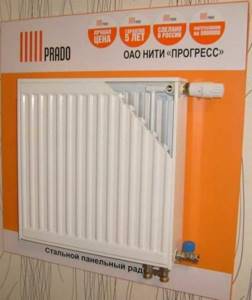
This is a model • Prado Universal with thermostatic valve
Prado Classic can be used in systems with any type of wiring; Prado Universal are intended for use in two-pipe systems. They are equipped with a thermostat with high hydraulic resistance. For installation in single-pipe systems, a special thermostat with low hydraulic resistance is required. If you plan to install a device of this type in a one-pipe system, purchase the “Classic” option and install a thermostat with a large flow area.
The lineup
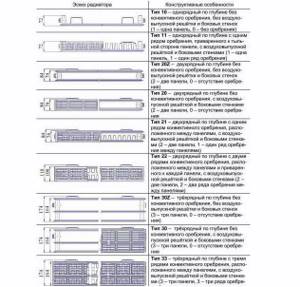
Design features of different types of radiators
The company's catalog includes Classic and Universal models. Products are available with side and bottom eyeliner. The manufacturer offers a wide range of standard sizes, allowing you to design the optimal heating system. Structurally, the devices consist of one, two or three panels, plus fins. The company's catalog presents several types of radiators. They differ in depth, number of panels, and the presence of fins.
Types of Prado batteries:
- Type 10 is the narrowest model (72 mm), consisting of one row of panels. Its advantage is its affordable cost. The disadvantages include low heating power.
- Type 11 - fins are welded to the back of the single-row panel. The product is equipped with an air outlet grille and side slats.
- Type 20 is a radiator with two panels, but without convection fins. There is a grill on top. Depth 82 mm.
- Type 21 - the model consists of two panels and fins between them. The heater received all the necessary finishing - grille and side inserts.
- Type 22 - stamped parts are arranged in two rows, a ribbed convector is welded to each. The depth of the product is 108 mm, there is a grill on top, and strips on the sides.
- Type 30 is a three-row radiator without fins. The model with the letter “Z” is offered without grille and sidewalls. Version with the letter "V" with vertical connection.
- Type 33 – three rows of ribbed panels form a depth of 172 mm. The radiator is fully equipped with finishing elements.
Prado Classic
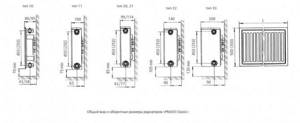
Prado Classic radiators are used in two-pipe and one-pipe communication networks. They can be installed in gravity systems and operating with pumping stations. There are holes on four sides of the product for lateral pipe connections. Classic radiators are available in all types. Their peculiarity is the absence of right and left execution. The heater can only be connected on one side; a plug is placed on the other.
Heating devices of the Z-hygienic series are intended for institutions with increased requirements for cleanliness. They are devoid of fins, side walls and grilles. When marking products, their type and dimensions are indicated. For example: model Prado Classic 22-500-500 – radiator with side connection type 22, length 500 mm, width 500 mm.
Prado Universal
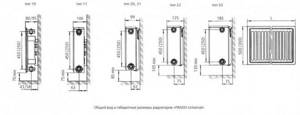
The advantage of Universal batteries is the universal connection. The design allows for bottom connection, hiding the heating pipes. A switching option is possible through 4 connecting holes in the corners of the device. Products are produced in various types, from single-row to three-row. There is also a Z series of hygienic heating devices. The devices are equipped with connecting pipes on the right and left sides, which simplifies installation. Steel Prado Universal radiators are equipped with Danfoss thermostats that control their power. The valves are designed for a two-pipe system. When installing batteries in a single-pipe network, choose models with reduced thermostat resistance.
Capacity and weight
| H=300 | ||
| 20Z | 30Z | |
| 400 | 5,16/1,5 | 8,05/2,25 |
| 500 | 6,28/1,88 | 9,7/2,82 |
| 600 | 7,40/2,26 | 11,35/3,39 |
| 700 | 8,52/2,64 | 13,04/3,96 |
| 800 | 9,64/3,02 | 14,69/4,53 |
| 900 | 10,76/3,4 | 16,34/5,1 |
| 1000 | 11,88/3,78 | 17,99/5,67 |
| 1100 | 13,00/4,16 | 19,64/6,24 |
| 1200 | 14,25/4,54 | 21,63/6,81 |
| 1300 | 15,37/4,92 | 23,28/7,38 |
| 1400 | 16,49/5,3 | 24,93/7,95 |
| 1500 | 17,61/5,68 | 26,59/5,52 |
| 1600 | 18,80/6,06 | 28,51/9,09 |
| 1700 | 19,92/644 | 30,16/9,66 |
| 1800 | 21,12/6,82 | 31,81/10,23 |
| 1900 | 22,24/7,2 | 33,46/10,8 |
| 2000 | 23,36/7,58 | 35,14/11,37 |
| 2200 | 25,23/8,34 | 37,57/12,51 |
| 2400 | 27,44/9,1 | 40,82/13,65 |
| 2600 | 29,64/9,86 | 44,04/14,79 |
| 2800 | 31,85/10,62 | 47,27/15,93 |
| 3000 | 34,06/11,38 | 50,52/17,07 |
| H=500 | ||
| 20Z | 30Z | |
| 400 | 8,18/2,25 | 12,62/3,37 |
| 500 | 10,06/2,82 | 15,41/4,21 |
| 600 | 11,94/3,38 | 18,20/5,05 |
| 700 | 13,82/3,94 | 21,00/5,89 |
| 800 | 15,70/4,5 | 23,76/6,74 |
| 900 | 17,58/5,07 | 26,55/7,58 |
| 1000 | 19,46/5,63 | 29,34/8,42 |
| 1100 | 21,34/6,19 | 32,13/9,26 |
| 1200 | 23,35/6,76 | 35,20/10,11 |
| 1300 | 25,23/7,32 | 37,99/10,95 |
| 1400 | 27,11/7,88 | 40,78/11,80 |
| 1500 | 28,99/8,44 | 43,58/12,64 |
| 1600 | 30,94/9,01 | 46,61/13,48 |
| 1700 | 32,82/9,58 | 49,37/14,32 |
| 1800 | 34,78/10,14 | 52,16/15,17 |
| 1900 | 36,66/10,7 | 54,95/16,01 |
| 2000 | 38,54/11,27 | 57,74/16,85 |
| 2200 | 41,93/12,39 | 62,42/18,54 |
| 2400 | 45,66/13,52 | 67,92/20,22 |
| 2600 | 49,38/14,64 | 73,39/21,91 |
| 2800 | 53,11/15,77 | 78,90/23,60 |
| 3000 | 56,84/16,9 | 84,40/25,28 |
Capacity and weight
| H=300 | ||
| 20Z | 30Z | |
| 400 | 5,16/1,5 | 8,05/2,25 |
| 500 | 6,28/1,88 | 9,7/2,82 |
| 600 | 7,40/2,26 | 11,35/3,39 |
| 700 | 8,52/2,64 | 13,04/3,96 |
| 800 | 9,64/3,02 | 14,69/4,53 |
| 900 | 10,76/3,4 | 16,34/5,1 |
| 1000 | 11,88/3,78 | 17,99/5,67 |
| 1100 | 13,00/4,16 | 19,64/6,24 |
| 1200 | 14,25/4,54 | 21,63/6,81 |
| 1300 | 15,37/4,92 | 23,28/7,38 |
| 1400 | 16,49/5,3 | 24,93/7,95 |
| 1500 | 17,61/5,68 | 26,59/5,52 |
| 1600 | 18,80/6,06 | 28,51/9,09 |
| 1700 | 19,92/644 | 30,16/9,66 |
| 1800 | 21,12/6,82 | 31,81/10,23 |
| 1900 | 22,24/7,2 | 33,46/10,8 |
| 2000 | 23,36/7,58 | 35,14/11,37 |
| 2200 | 25,23/8,34 | 37,57/12,51 |
| 2400 | 27,44/9,1 | 40,82/13,65 |
| 2600 | 29,64/9,86 | 44,04/14,79 |
| 2800 | 31,85/10,62 | 47,27/15,93 |
| 3000 | 34,06/11,38 | 50,52/17,07 |
| H=500 | ||
| 20Z | 30Z | |
| 400 | 8,18/2,25 | 12,62/3,37 |
| 500 | 10,06/2,82 | 15,41/4,21 |
| 600 | 11,94/3,38 | 18,20/5,05 |
| 700 | 13,82/3,94 | 21,00/5,89 |
| 800 | 15,70/4,5 | 23,76/6,74 |
| 900 | 17,58/5,07 | 26,55/7,58 |
| 1000 | 19,46/5,63 | 29,34/8,42 |
| 1100 | 21,34/6,19 | 32,13/9,26 |
| 1200 | 23,35/6,76 | 35,20/10,11 |
| 1300 | 25,23/7,32 | 37,99/10,95 |
| 1400 | 27,11/7,88 | 40,78/11,80 |
| 1500 | 28,99/8,44 | 43,58/12,64 |
| 1600 | 30,94/9,01 | 46,61/13,48 |
| 1700 | 32,82/9,58 | 49,37/14,32 |
| 1800 | 34,78/10,14 | 52,16/15,17 |
| 1900 | 36,66/10,7 | 54,95/16,01 |
| 2000 | 38,54/11,27 | 57,74/16,85 |
| 2200 | 41,93/12,39 | 62,42/18,54 |
| 2400 | 45,66/13,52 | 67,92/20,22 |
| 2600 | 49,38/14,64 | 73,39/21,91 |
| 2800 | 53,11/15,77 | 78,90/23,60 |
| 3000 | 56,84/16,9 | 84,40/25,28 |
Correction factor
Well
| WITH | φ for standard sizes | ||
| 10-300, 10-500, 11-300 | 20-300, 20-500 | 11-500, 21-300, 21-500, 22-300, 22-500, 30-300, 30-500, 33-300, 33-500. | |
| 36 | 0,433 | 0,427 | 0,421 |
| 38 | 0,463 | 0,458 | 0,452 |
| 40 | 0,494 | 0,489 | 0,483 |
| 42 | 0,525 | 0,52 | 0,515 |
| 44 | 0,557 | 0,552 | 0,547 |
| 46 | 0,589 | 0,584 | 0,579 |
| 48 | 0,622 | 0,617 | 0,612 |
| 50 | 0,654 | 0,65 | 0,646 |
| 52 | 0,688 | 0,684 | 0,679 |
| 54 | 0,721 | 0,717 | 0,714 |
| 56 | 0,755 | 0,752 | 0,748 |
| 58 | 0,789 | 0,786 | 0,783 |
| 60 | 0,823 | 0,821 | 0,818 |
| 62 | 0,858 | 0,856 | 0,854 |
| 64 | 0,893 | 0,892 | 0,89 |
| 66 | 0,929 | 0,927 | 0,926 |
| 68 | 0,964 | 0,964 | 0,963 |
| 70 | 1 | 1 | 1 |
| 72 | 1,036 | 1,037 | 1,037 |
| 74 | 1,073 | 1,074 | 1,075 |
| 76 | 1,109 | 1,111 | 1,113 |
| 78 | 1,146 | 1,149 | 1,151 |
| 80 | 1,183 | 1,186 | 1,19 |
| 82 | 1,221 | 1,224 | 1,228 |
| 84 | 1,258 | 1,263 | 1,267 |
| 86 | 1,296 | 1,301 | 1,307 |
| 88 | 1,334 | 1,34 | 1,346 |
| 90 | 1,373 | 1,379 | 1,386 |
Reviews about battery performance
Despite the disadvantages, most users were satisfied with the purchase and now choose only Prado radiators. Reviews about them are mostly positive, but there are also specific suggestions regarding the operation and design of the battery.
Many people say that the radiators are of quite high quality, and therefore recommend them to all their friends. These batteries have a temperature control, which many users like. Some people struggle with setting it up at first, but adapt over time.
As with any other product line, Prado sometimes comes across defective models. But if you come across a radiator with a flaw, the store will undoubtedly replace it for you.
Review of other steel radiator manufacturers
Today the following brands have achieved popularity:
- DELONGHI (Italy). A well-known Italian company, distinguished by its quality of workmanship, reliability, painting and high heat transfer characteristics. DELONGHI steel panel radiators are used in country houses, office buildings, and cottages. Less common in apartments.
- ELBA (Türkiye). Fair value for money. Ideal for installation in private homes and budget cottages.
- GRANDINI (Türkiye). Radiators are available in various modifications and sizes. Side and bottom eyeliners are possible.
- IMAS (Italy). Considered one of the best producers in Italy. Reliable and high-quality products at the lowest cost. The warranty period is 10 years.
- KERMI (Germany). German quality. Installed in retail, office buildings and cottages.
- KORAD (Slovakia). The products are made from quality materials. Warranty period - 6 years.
- KORADO (Czech Republic). Radiators of this brand are in great demand among installation and construction organizations. It has the advantages of all famous world brands, while remaining affordable. Used in all types of premises.
- VOGEL & NOOT (Austria). The brand is characterized by a wide range of products of different shades and sizes. High-quality products for the housing stock. The warranty period is 10 years.
- PURMO (Finland). An ideal connection option for low-temperature boilers. The high price range is dictated by the excellent quality of the product.
- WARMEKRAFT (Türkiye). Budget models with decent quality. The warranty period is 10 years.
Steel panel radiators from all of the above manufacturers have a working pressure of 10 atmospheres, except for WARMEKRAFT - 11 atmospheres and KORAD - 8.7 atmospheres.
Related Posts
- Houses made of kiln-dried profiled timber
- Technical characteristics of FBS foundation blocks
- Floor screed mortar
- Conner radiators
- Thickness of aerated concrete walls
- Pragma sewer pipes
- What is one for electricity?
- Copper-aluminum radiators. What is the strength in, brother?
- Dismantling of heating systems
- Voltage stabilizer for boiler
- Which heating radiators are best for an apartment: secrets of choice
- Fiberboards: what is it?
- Comparison of heating radiators by heat transfer
- Concrete weight
- Caspian (road)
- Hydrogen heating boilers: why you should not choose a hydrogen fuel boiler for heating a private home, review and comparison of efficiency and economy, the best models and their prices
- Metal radiators
- Characteristics and subtleties of installing noise suppressors for ventilation
- Do-it-yourself heating options for a country house
- Facade thermal panels for exterior decoration of a house: characteristics and installation
- Ventilation control panel: device, purpose + how to assemble correctly
- Selecting a machine by power
- Cement laitance: what is it, where is it used, how to prepare, consumption
- 9 best aluminum radiators
- Covering the roof of a house
Read with this
- Houses made of kiln-dried profiled timber
- Technical characteristics of FBS foundation blocks
- Floor screed mortar
- Conner radiators
- Thickness of aerated concrete walls
- Pragma sewer pipes
- What is one for electricity?
- Copper-aluminum radiators. What is the strength in, brother?
- Dismantling of heating systems
- Voltage stabilizer for boiler
About company
The company engaged in the manufacture of the radiators in question has a fairly rich history, as it was founded in the city of Izhevsk back in 1959. NITI "Progress" at that time was one of the leaders of engineering and technical thought in the USSR. After the collapse of the Soviet Union, the company underwent reorganization and repurposing.
It should be noted that the production of steel heating radiators at the production facilities of NITI "Progress" was mastered relatively recently - in 2005. It was then that the Prado trademark arose. In parallel with this, a trading house was opened in Izhevsk, the main task of which was to promote Prado radiators on the domestic market.
Today, heating batteries produced under this brand have gained popularity not only in the Russian Federation, but also in other CIS countries. Moreover, the products of the Prado trading house have been repeatedly awarded with cups at industry exhibitions and awarded with diplomas.
